Government’s ill-planned move puts future of 1.3 million children is at risk
Due to the government’s lack of readiness for the complete enforcement of the Compulsory and Free Education Act-2075, scheduled to take effect in April 2028, it is anticipated that approximately 1.3 million children may miss out on fundamental opportunities.
Bhagirathi Pandit |CIJ Nepal
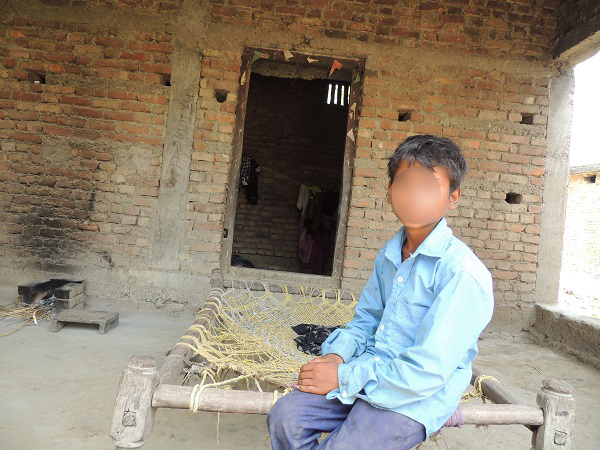
Ramlakhan Harijan, a student of Sundi High School Class-4, Mayadevi -4, Rupandehi
Ramlakhan Harijan, a fourth grader at Sundi High School in Banaksia, Mayadevi Rural Municipality-4 of Rupandehi, doesn’t go to school regularly. When we looked at the attendance register, we found that he attended classes only for eight days in two months (April and May). The school, which is close to house, opened for 33 days in the two months, but he was absent for 25 days.
Ramlakhan’s father passed away six years ago and mother also two years ago. Without the parents, there’s no one to take care of him and send him to school. He has two brothers, who work to put the food on the table every evening. When they don’t bring anything, Ramlakhan sleeps on an empty stomach. Even when the brothers bring home rice, Ramlakhan has to look for firewood.
After the death of his mother, Ramlakhan, who dropped out of school, was enrolled in the school by a teacher who bought him stationery. Due to his performance in the entrance exam, he was placed in grade 4. “Earlier he had some reading and writing skills, but now he has forgotten everything,” said headmaster Satishmani Tripathi. “He has forgotten many things because he was out of school for two years, so we placed him in the fourth grade.”
Although he is now enrolled in school, his hungry stomach hinders his studies. Headmaster Tripathi says he believes that it is necessary to arrange food and accommodation for Ramlakhan to attend school regularly.
When we asked his grandfather Hareram Lodh why eight-year-old Siva Lodh of Mayadevi Rural Municipality-5 Bhaisehwa of Rupandehi did not go to school, he initially replied,”I don’t know!”
After a while he explained to us why Shiva wasn’t in school. Hareram said that Shiva often returned home without completing his classes. That’s why the family stopped sending him to school. No one can read or write in the family of seven. Shiva’s father works as a laborer in India.
Shiva, who spends his days playing in the village, has two other friends like him, the brothers Kisan (10) and Raksha Kahar (12). Raksha went to school for a week four years ago. Kisan was enrolled in grade 3. All of them neither want to go to school nor face family pressure to do so. Raksha and Kisan’s sister Rupa is also unable to go to school. ” I don’t have money to buy stationery, so I didn’t get enrolled, ” said Rupa.
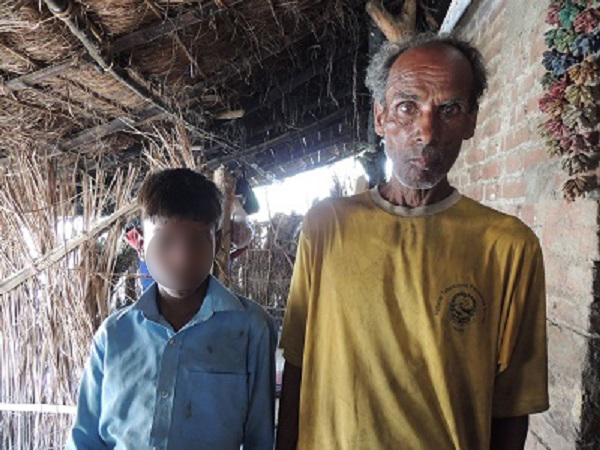
Shiva Lodh and his grandfather Hareram Lodh of Mayadevi -5.
Mayadevi Rural Municipality, Rupandehi, doesn’t maintain records of children out of school. But in the scholastic year 2022/23, the number of students attending classes 1-8 stands at 11,960. Madhusudan Belbase, technical Assistant at the Education Department of the rural municipality, said that around 0.57 percent of them, (around 68) may have dropped out of school.
When he reached Mayadevi-2 Bharwalia village of Kapilvastu, the seven-year-old Prince was playing marbles in the afternoon. He said that he couldn’t attend school because it was far away.
Although private school buses come to pick children up in the area, most of the families can’t afford to pay their fees. It takes about an hour for children such as Prince to reach the nearest public school. In this family of seven, the eldest daughter and the second daughter have studied up to grade 8. The third (10) and youngest (9) study in grades 4 and 5 at an informal school under the Nepal CLS project. As the family can afford to only send two members of the family to school, Prince couldn’t attend school. His mother and elder sister said that father Mahesh wasn’t interested in his son’s studies. Living in one room, this family is struggling to make ends meet.( see Info -1)
According to a survey conducted by Mayadevi Rural Municipality, 457 people in the 5-20 age group haven’t completed basic education. Among them, 78 falling in the 5-12 years age group don’t go to school. A total of 33 were never enrolled in school and 45 said they dropped out.
When we talked to Waliuddin Musalman, the chair of ward No 2, Varwaliya, he told us that 21 children under 12 years of age don’t attend school in the village. This means that more children are out of school compared to the date provided by the rural municipality.
According to a study conducted by Mayadevi Rural Municipality and Sunshine Social Organization, which works in school education, the poor financial condition of the family is the main reason why children don’t go to school. Apart from that, there are other reasons such as living far from school, having to do housework , lacking awareness and having a disability.
Enrollment, retention rates and dropout rates
In Nepal, not only are children not enrolled in school , but there is also a problem of not staying in school. According to government data, 3.1 percent of children are still out of school. According to the Center for Education and Human Resource Development in 2022/23, the dropout rate for grade 1 was 4.4 percent; 2 percent for grade 2 , 2.4 percent for grade 3; 2.1 percent for grade 5; 2.5 percent for grade 6; 3.9 percent for grade 7 and 3.7 percent percent for grade 8.

Source: Center for Education and Human Resource Development, 2023
Although the proportion of children who drop out from different grades seems low, according to the center’s data for 2022/23, the overall dropout rate for classes 1-8 stands at 20.9 percent. Between 2019/20 and 2020/21, the enrollment rate also fell by almost 1 percentage point from 96.3 percent to 95.5 percent.
1.3 million more children likely to be affected
According to section 19 (1a) of the Compulsory and Free Education Act- 2075, persons who have not completed basic level (Class-8) won’t be allowed to work in government offices from April 13, 2028. It also prohibits those without basic education from doing business. It states that those who haven’t completed basic education shall not be allowed to start or invest in a company or be appointed as a director of a company, firm, cooperative or any other non-governmental organization.
Not only that, a person who hasn’t studied up to the basic level will be ineligible to be elected, appointed or nominated to any position in the governmental, non-governmental or private sector.
However, the law also mentions that this provision will not affect those who were at least 12 years of age before April 13, 2028. Similarly, the law won’t be applicable to those who couldn’t get formal education due to poor health or multiple disabilities.
According to this Act, which was passed five years ago, all the provisions will come into force from April 13, 2028. However, local governments responsible for its implementation are unaware about its provisions. The federal government has also not made any preparations for the implementation of the legislation.
Although the government has set a goal of providing free education for 10 years and providing basic education to all by 2028, the situation doesn’t seem like that. Even after five years after the Act became law, there’s little progress in terms of free and compulsory education. It seems impossible for the government to enroll all children in school and have them complete basic level of education in the next five years. Educationist Dr Vinay Kusiait says it seems impossible to fulfill the objectives of the government’s investments and programs in the education sector.

Projection based on fertility, mortality, death, enrollment and dropout rates as reported by the 2021 census.
In 2021, a total of 245,758 children were out of school. This figure includes 221,825 children not enrolled in school and 23,933 children who have dropped out. According to the Center for Education and Human Resources, 40,917 people attended classes 1-8 during the scholastic year.
According to government projections based on 2021 data, by 2028, the number of children not going to school will reach 377,522 and the number of those who fail to complete basic education will be 952,950. This means that around 1,333,483 will be affected by the new legislation.
According to the Compulsory and Free Education Act – 2075, these children will be deprived of jobs in government offices, even as assistants, or doing any business of their own choice.
Looking at the provincial data, 332,678 children in Madhesh, 232,313 in Lumbini and 216,542 in Bagmati will be affected by the legislation. (हे. इन्फो–१)
The data entered by public schools in the Integrated Educational Management Information System (EIMIS) and the data found during the on-site studies don’t add up. Educators and officials of the Ministry of Education agree that a larger number of children are out of school than the figures from schools or municipalities suggest. Ramchandra Sharma, director at the Center for Education and Human Resource Development, informed that when he reached the districts of Madhesh, the number of children staying out of school was higher than the government data.
Why are children out of school ?
According to the Center for Human and Education Development Resource, only 83.5 percent of children enrolled in grade 1 reach grade 8.

Kisan and Raksha Kahar with their mother.
Especially in hilly and Himalayan areas, students are unable to attend classes regularly as schools are far from their settlements. According to Arun Kumar Das, Head of Education at Dolpo Buddha Rural Municipality, there is only one secondary school in Upper Dolpa.
It takes three days to reach the secondary school from remote villages. Children from faraway places live in rented rooms, families with poor financial conditions can’t afford the expenses.
According to the Ministry of Finance’s recent Economic Survey, the population below the poverty line in Nepal is 15.1 percent. Most of the children of this group don’t have access to schools.
Like Kapilvastu and Mayadevi Rural Municipality of Rupandehi, education is still not a priority for most of the poor of Madhesh. Punarvasi Kahar, a member of the Haji Aiayatullah Community Education Management Committee in Mayadevi Rural Municipality-5, Semarhana, Rupandehi, says, “Parents do not have the awareness that their children should receive formal education. We need to visit the parents regularly to explain to them the importance of education.”
Satishmani Tripathi, headmaster at Sundi Secondary School located in Banaksia, Mayadevi Rural Municipality-4, Rupandehi, says that scholarships alone don’t attract poor and helpless students. According to him, they won’t be able to attend classes unless the government helps them do better in their lives. He believes that if the local government can connect poor families with jobs and skills, the school enrollment rate will go up.
Ved Prakash Joshi, headmaster of Jalpa Secondary School in Badimalika Municipality of Bajura, says, “The parents themselves aren’t educated. When they go to India or other parts of the country for employment, the children can’t come to school. At the root of it all is poverty.”
According to Dhirendra Choudhary, headmaster of the National Secondary School in Rupaitha Velhi, Janakpur, the biggest problem in the school is the lack of proportionate teacher to student ratio. “The recruitment of new subject teachers has become a pipe dream,” says Chaudhary, ” No matter how much the government claims to have improved the physical structure of schools, the condition of schools in Madhesh, Sudurpaschim and Karnali provinces is critical.” He says that school education has failed to attract children and parents.
He narrated the experience of not being able to enroll children out of school due to lack of physical infrastructure and teachers. He said, “Only 75 percent of those enrolled in grade 1 reach grade 8. Even now, 5 percent of children in the community are out of school.” He also said that there are only 13 classrooms in the school, which operates up to 12th standard.
There is also a lack of physical infrastructure at Mukot Himal, Shey Phoksundo Rural Municipality, Dolpa. Principal Netra Budha says, “We teach students of up to grade 3. Children from far away don’t come. Many students go to cattle herding after studying till grade 3.” According to him, as Buddhist people live in the area, children leave the village to get religious education and the number of dropouts is high.
The lack of teachers who can teach in the local Dolpo language, adds to the challenge.
Ramniwas Chauhan, headmaster of Janata Secondary School, Mayadevi-5 Baluhwa, Kapilvastu, says that burdensome homework , bullying and punishment are also discouraging children from going to school. He says, “Teachers and school children must be compatible, teachers must become facilitators.” It will be difficult to keep children in school until they have an environment where they can enjoy themselves.”
Among the 38 schools in Palpa’s Ribdikot Rural Municipality, Narayan Secondary School has the highest dropout rate (13.9 percent). Principal Dhal Bahadur Thapa says,” The settlement in Chure areas is thin, students don’t come regularly as the school is far from their homes.” According to Rita Rana, principal of Tallung Secondary School of the municipality, only 85 percent of those admitted complete basic education. On top of that, there are problems like child marriage and compulsion to do household work and go work.. She says , ” There is a lack of water and toilets in the school itself.”
Unaware local government, federal government doesn’t coordinate efforts
Most of the people’s representatives at the local level are unaware of the compulsory and free education law. Because of this, they haven’t devised targeted programs. What is more interesting is how many children are out of reach of schools , how many drop out , why children do not come to school and most of the local governments don’t maintain data related to this..
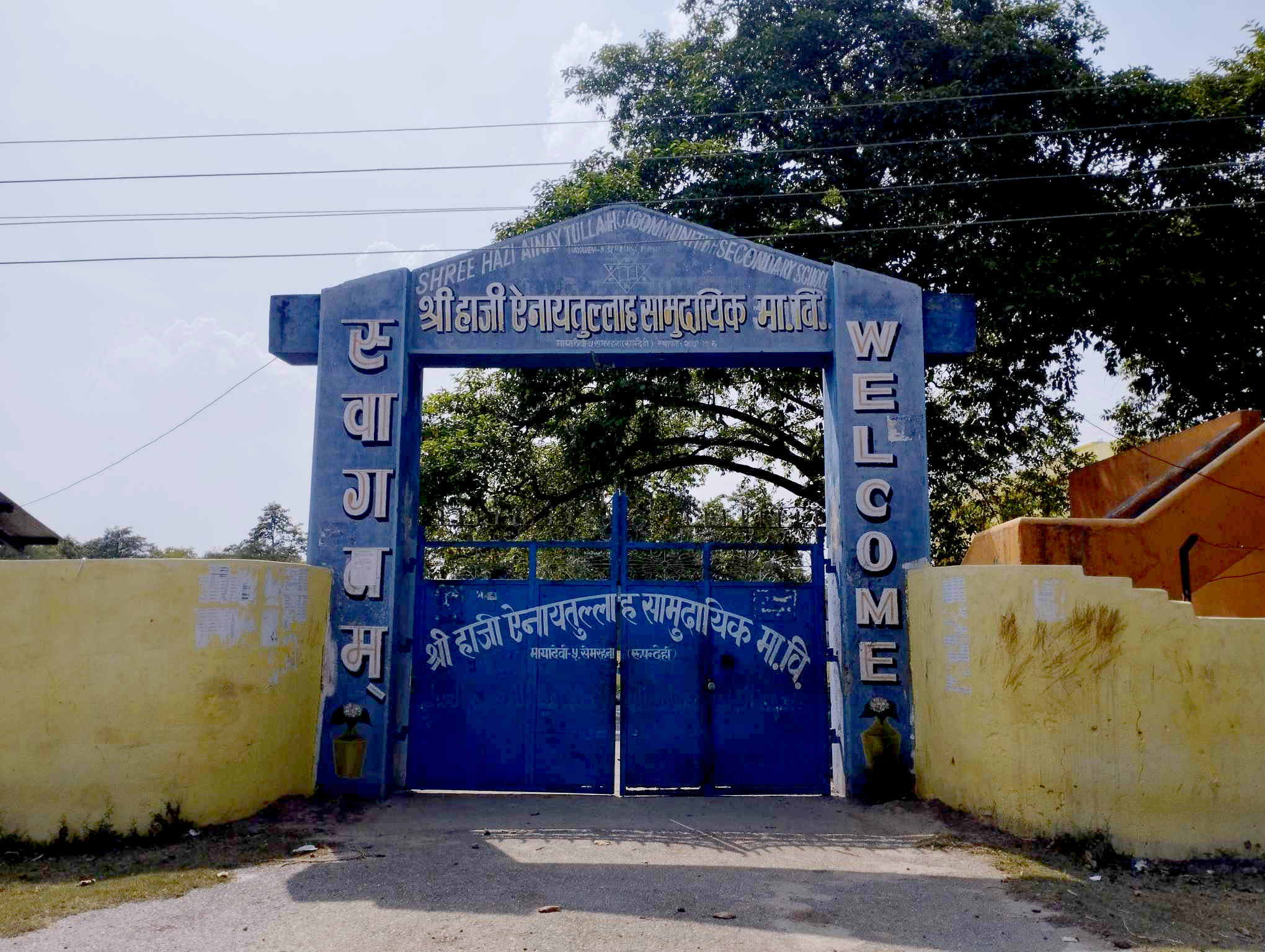
Valiuddin Muslim, Chairman of Kapilvastu Mayadevi Rural Municipality, is also not aware of the compulsory education Act. In his ward, 21 children are out of school. Madhav Ghimire, head of the education branch of the rural municipality, says , ” Unless the people’s representatives prioritise this issue, the budget for education will remain inadequate. Up to Rs 15 million is spent on teacher’s salary alone. The budget is not enough to formulate focused programs to implement the law.”
Chairman of Rupandehi’s Mayadevi Rural Municipality Dhuravan Narayan Chaudhary also says that he is not aware of the compulsory education Act. Like Mayadevi of Kapilvastu, the Mayadevi of Rppandehi has not made any programs to bring children to school and retain them.
Narayan Lamichhane, head of the education department of the municipality, says ,” It hasn’t been possible to bring a program aimed at students who don’t go to school regularly and those that drop out. Support from the province and the federal government is also needed to conduct special programs for such children and their families.
Janakpurdham Sub-metropolitan city’s education department chief Anju Pandey says that scholarships, free textbooks and mid-day meals given by the federal government have not reached the children of marginalized communities. She says, “ There are many children in schools in Madhesh , they can’t get enough teachers. How do we think about programs envisaged by the law!”
All three levels of government are responsible for implementing the Act. Coordination among all three levels of government is also needed in the planning and implementation of targeted programmes.Deepak Sharma, spokesperson for the Ministry of Education, says , “It is the responsibility of the federal government to set national standards , make plans, and manage the budget for the implementation of the Act.” The state government should also support this.”
But the Association of Municipalities and the Federation of Rural Villages accuse the federal government of not coordinating the implementation of the law. “Directions alone are not sufficient to implement the law,” says Bhim Prasad Dhungana, president of the Municipal Association , ” The budget allocated for education is very low.” For the implementation of the Act, the government should allocate around 20 to 25 percent of its annual budget for education.”
Lakshmi Pandey, president of the National Federation of Rural Villages, says that local governments have been unable to do much work in the last five years due to the confusion created by the federal government. According to him, in order to provide compulsory education to children, the families below the poverty line should be uplifted and there should be cooperation between the three levels of government.
Sharma, the spokesperson of the ministry, also admits that the federal government has not reviewed the Act even after five years have passed since its passing.
The government introduced the Compulsory and Free Education Act 2075 with the aim of implementing the basic and fundamental rights granted by the constitution. This is a legal system that ensures easy and equitable access and continuity of education for everyone.
The Act itself, imagines programs of formal education (school education) as well as alternative education , non-formal and open education and traditional education as support programs for basic level education opportunities.
The government has failed to make adequate preparations, allocate budget and implement the program, says education expert Dr Bidyanath Koirala. According to him, in order to implement the Compulsory and Free Education Act, it is necessary to create programmes with a special plan. However , looking at the budget allocated in the last five years, the government’s investment in education is not promising, he added.
In the current fiscal year, the government has allocated 11.64 percent of the budget for education. Last year it was 11 percent. In the previous years it was 10.91 percent, 11.64 percent and 10.68 percent respectively. .
Also, the provincial governments haven’t fulfilled their responsibilities for the implementation of the Act. Manoj Kumar Gaire, spokesperson for the Ministry of Social Development of Lumbini Province, says the provincial finance ministry hasn’t allocated a budget for programs envisaged by the Compulsory and Free Education Act. He said that according to the law of the province, a certain amount of money should be allocated as an unconditional grant for the implementation of the Act, but the allocation could not be made due to the promulgation of the School Education Act.
Dr Vinay Kumar Kusiait, who has assessed the education budget of all three levels of government, says , ” The government can’t afford the money required to implement compulsory and free education. Only 42 to 44 percent of the total expenditure on education up to the secondary level is spent by the government. According to Kusiait, the share of the investment made by the rest of the community includes the fees charged in the name of support through the parents.
According to him, there are 53,000 teacher vacancies in public schools. School structures are not the same in all places. How can children from poor families study in this situation ? He questions , ” The school is charging a fee in a roundabout way saying that there is a shortage of teachers , and there are people in the community who can’t send their children to school because the fees are too expensive.” On the other hand, he argues that the lack of education related to life and skills has increased frustration among parents and the community.
The Act and its regulations made basic education mandatory and free three years ago..But due to the lack of clear delineation of responsibilities has hindered progress, educationist Prof. Dr. Vidyanath Koirala says.
According to him, Schedule 8 of the constitution has given the sole right of education up to the secondary level to the local government. Not only the current government, but also the political parties and employees, haven’t agreed to give the local government the sole authority . So far, none of the municipalities have been able to implement the law , and they have not received an order from anywhere that it should be implemented. If the leadership doesn’t provide an order , the municipalities haven’t dared to act, he said, He believes that this law can’t be implemented until the municipality dares to do so/.
In this situation, if children under 12 years of age don’t pass grade 8, they won’t get government and private jobs as well as services provided by the government , ” he said. . Now in five years, everyone should be given the opportunity to study through open and alternative means to achieve the qualification equivalent to class 8.
Currently, almost 20 percent of children are out of school in Madhesh. “Who will bear the responsibility of these children? The local government has not taken responsibility. The provincial and federal governments have also neglected it,”said Koirala..
It is alleged that this Act was brought to cover the face of school education caught in the net of private educational institutions , says educationist Dr. of Vishnu Karki. “Teachers’ salaries , school staff , textbooks , libraries , ICT labs and many other things are connected with education. How are all these resources being managed ? ” Karki says.




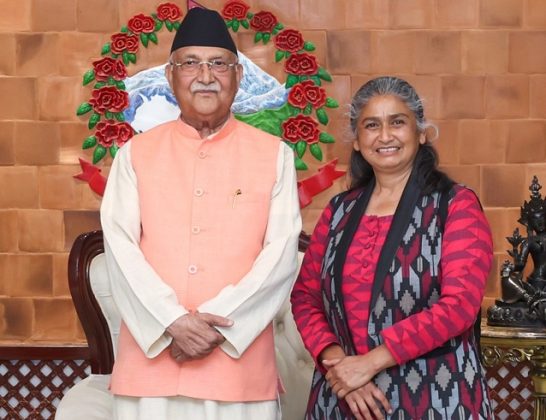
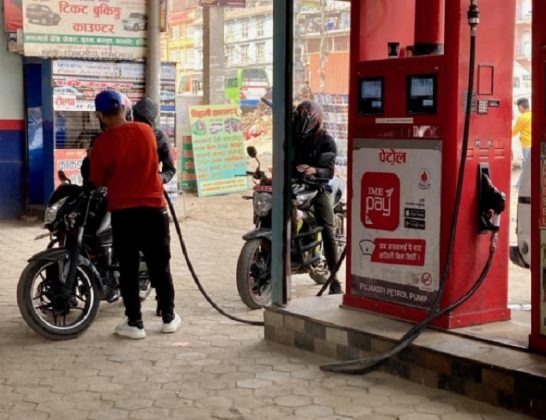
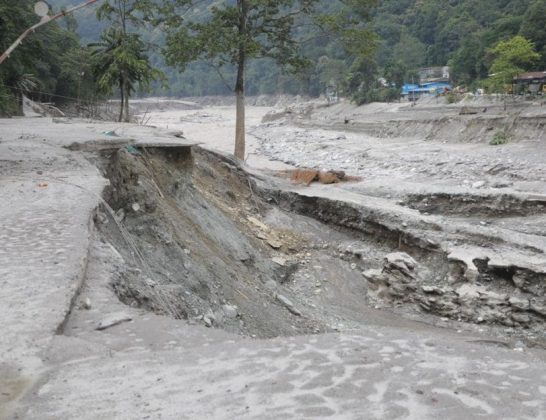
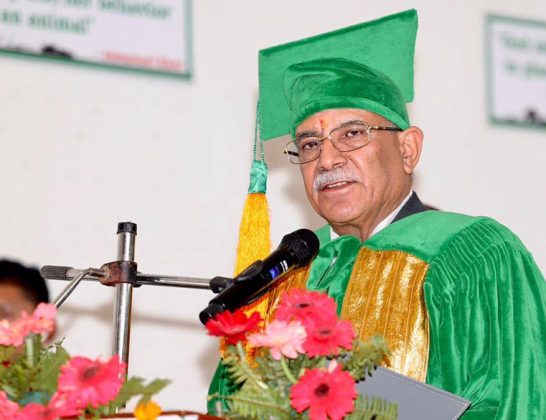


Comments